Preparation and Characterization of Pulse Electrodeposited Ni/W-SiC Nanocomposite Coating on Mild Steel Substrate
Abstract
:1. Introduction
2. Experiment and Characterization
3. Results and Discussion
3.1. Surface Morphology Observation
3.2. AFM Survey
3.3. XRD Measurement
3.4. Microhardness Analysis
3.5. Friction Performance Test
4. Conclusions
- The S1 and S4 nanocomposites’ microstructures reveal many large cauliflower-shaped grains. The S2 nanocomposite demonstrates the most homogeneous, finest, and smoothest surface morphology. The smooth surface structure of the S2 nanocomposite has depths of depression, and protrusion heights are 78.5 nm and 109.7 nm, respectively.
- The diffraction angles of the S1 nanocomposite are 41.2°, 51.7°, and 71.2° depicting the sharpest diffraction peaks, corresponding to the (1 1 1), (2 0 0), and (2 2 0) crystal planes of Ni-W grains, respectively. In addition, the average hardness of the S2 nanocomposite is ~905.3 HV.
- The S2 nanocomposite exhibits the lowest wear depth and width of 34.2 μm and 5.5 mm, respectively. Some wide and deep grooves are observed on the surface of the S1 nanocomposite, indicating that this nanocomposite exhibits the worst friction performance.
Author Contributions
Funding
Institutional Review Board Statement
Informed Consent Statement
Data Availability Statement
Conflicts of Interest
References
- Dilek, S.; Algül, H.; Akyol, A.; Alp, A.; Akbulut, H.; Uysal, M. Pulse electro co-deposition of submicron-sized TiC reinforced Ni–W coatings: Tribological and corrosion properties. J. Asian Ceram. Soc. 2021, 9, 673–685. [Google Scholar] [CrossRef]
- Li, H.; He, Y.; Luo, P.; Xue, S.; Li, Z.; Cheng, X.; Zhong, J.; Yan, L.; Fan, Y. Synthesis of ZrB2 strengthened Ni W composite coating and study of its mechanical characters and anti-corrosion performance. Surf. Coat. Technol. 2022, 441, 128553. [Google Scholar] [CrossRef]
- Zhang, C.; Zhang, B.; Xie, L. Improving mechanical properties of Ni-W based nanocrystalline films by multilayered architecture. Surf. Coat. Technol. 2020, 402, 126341. [Google Scholar] [CrossRef]
- Xu, J.; Li, Z.; Zhu, W.; Liu, Z.; Liu, W. The comparative study of thermal fatigue behavior of laser deep penetration spot cladding coating and brush plating Ni–W–Co coating. Appl. Surf. Sci. 2006, 253, 2618–2624. [Google Scholar] [CrossRef]
- Li, C.; Xia, F.; Ma, C.; Li, Q. Research on the corrosion behavior of Ni-SiC nanocoating prepared using a jet electrodeposition technique. J. Mater. Eng. Perform. 2021, 5, 1–9. [Google Scholar] [CrossRef]
- Popczyk, M.; Niedbaa, J. Characterization of corrosion resistance of Zn-Ni-W and Zn-Ni-P-W heat-treated coatings. Inżynieria Powierzchni 2021, 25, 13–17. [Google Scholar] [CrossRef]
- Li, B.; Zhang, W.; Zhang, W.; Huan, Y. Preparation of Ni-W/SiC nanocomposite coatings by electrochemical deposition. J. Alloys Compd. 2017, 702, 38–50. [Google Scholar] [CrossRef]
- Krasikov, A.V.; Bykova, A.D.; Merkulova, M.V.; Markov, M.A. Electrochemical deposition of nanocrystalline Ni–W coatings from citrate electrolytes. Vopr. Mater. 2020, 1, 111–117. [Google Scholar] [CrossRef]
- Xia, F.; Li, C.; Ma, C.; Li, Q.; Xing, H. Effect of pulse current density on microstructure and wear property of Ni-TiN nanocoatings deposited via pulse electrodeposition. Appl. Surf. Sci. 2021, 538, 148139. [Google Scholar] [CrossRef]
- Wasekar, N.; Latha, S.M.; Ramakrishna, M.; Rao, D.; Sundararajan, G. Pulsed electrodeposition and mechanical properties of Ni-W/SiC nano-composite coatings. Mater. Des. 2016, 112, 140–150. [Google Scholar] [CrossRef]
- NWasekar, P.; Bathini, L.; Ramakrishna, L.; Rao, D.S.; Padmanabham, G. Pulsed electrodeposition, mechanical properties and wear mechanism in Ni-W/SiC nanocomposite coatings used for automotive applications. Appl. Surf. Sci. 2020, 527, 146896. [Google Scholar] [CrossRef]
- Lin, C.; Chen, K.; He, J. The cavitation erosion behavior of electroless Ni-P-SiC composite coating. Wear 2006, 261, 1390–1396. [Google Scholar] [CrossRef]
- Zhang, Z.; Xian, J.; Wu, H.; Jin, M.; Shen, Z. Influence of particle concentration on the elemental penetration region and properties of Ni-P-SiC composite coatings prepared through sandblasting and scanning electrodeposition on 45 steel surfaces. Coatings 2021, 11, 1237. [Google Scholar] [CrossRef]
- Sfaira, M.; Srhiri, A.; Keddam, M.; Takenouti, H. Corrosion of a mild steel in agricultural irrigation waters in relation to partially blocked surface. Electrochim. Acta 1999, 44, 4395–4402. [Google Scholar] [CrossRef]
- Cai, C.; Yin, J.; Zhang, Z.; Yang, J. The electrodeposition of nanostructured Ni-TiN composite films. Mater. Sci. Forum 2009, 620–622, 727–730. [Google Scholar] [CrossRef]
- Wang, P.; Cheng, Y.; Zhang, Z. A study on the electrocodeposition processes and properties of Ni-SiC nanocomposite coatings. J. Coat. Technol. Res. 2011, 8, 409–417. [Google Scholar] [CrossRef]
- Xia, F.; Li, Q.; Ma, C.; Liu, W.; Ma, Z. Preparation and wear properties of Ni/TiN-SiC nanocoatings obtained by pulse current electrodeposition. Ceram. Int. 2020, 46, 7961–7969. [Google Scholar] [CrossRef]
- Sun, C.; Liu, X.; Zhou, C.; Wang, C.; Cao, H. Preparation and wear properties of magnetic assisted pulse electrodeposited Ni-SiC nanocoatings. Ceram. Int. 2019, 45, 1348–1355. [Google Scholar] [CrossRef]
- Zhang, H.; Xia, F.; Wang, J.; Xu, F. Influence of duty cycle and pulse frequency on structures and performances of electrodeposited Ni-W/TiN nanocomposites on oil-gas X52 steels. Coatings 2021, 11, 1182. [Google Scholar] [CrossRef]
- Yang, X.; Zhang, M.; Huang, Y.; Hu, X.; Pan, Y.; Cheng, S.; Mu, D.; Ding, Y. Preparation and friction and wear resistance of SiC/Ni nano-composite coatings. Mater. Mech. Eng. 2014, 38, 53–57. [Google Scholar] [CrossRef]
- Liu, W.; Jiang, K.; Li, Q.; Ma, C.; Xia, F. Jet pulse electrodeposited Ni-SiC thin coatings by using experimental system designed for potential industrial application. Int. J. Electrochem. Sci. 2021, 16, 21044. [Google Scholar] [CrossRef]
- Lattanzi, L.; Etienne, A.; Li, Z.; Chandrashekar, G.; Gonapati, S.; Awe, S.; Jarfors, A. The effect of Ni and Zr additions on hardness, elastic modulus and wear performance of Al-SiCp composite. Tribol. Int. 2022, 169, 107478. [Google Scholar] [CrossRef]
- Bratu, F.; Benea, L.; Celis, J. Tribocorrosion behaviour of Ni-SiC composite coatings under lubricated conditions. Surf. Coat. Technol. 2007, 201, 6940–6946. [Google Scholar] [CrossRef]

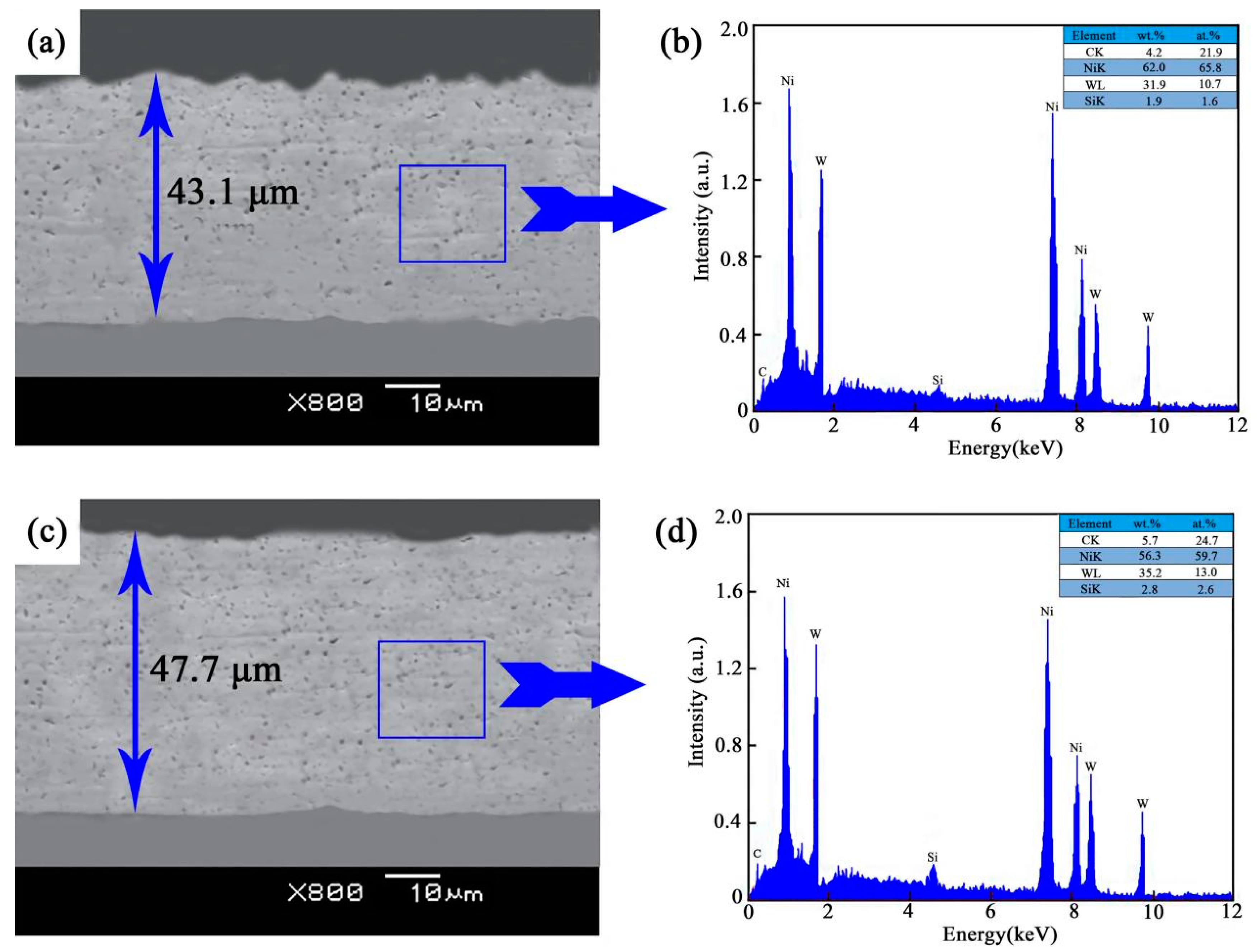
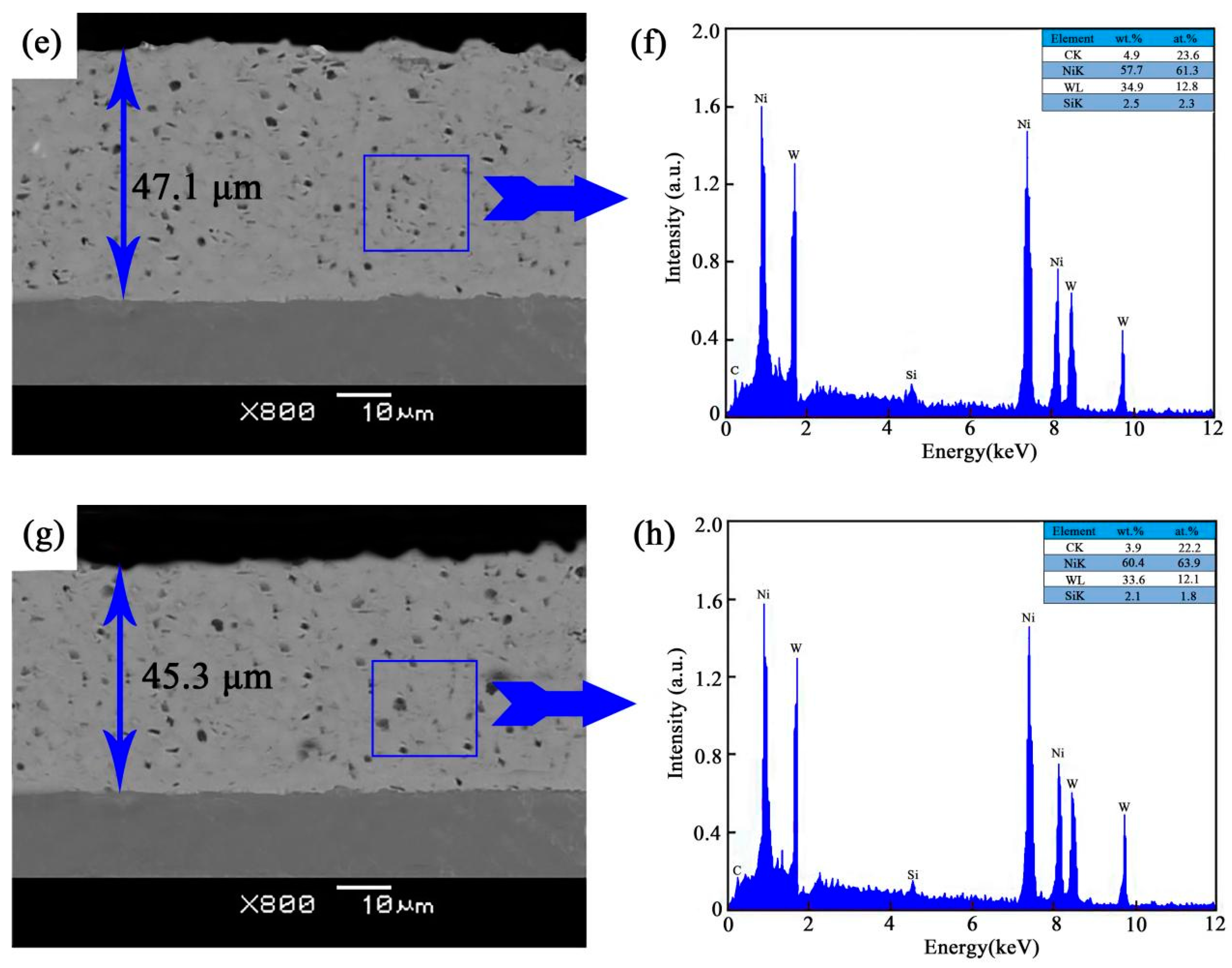
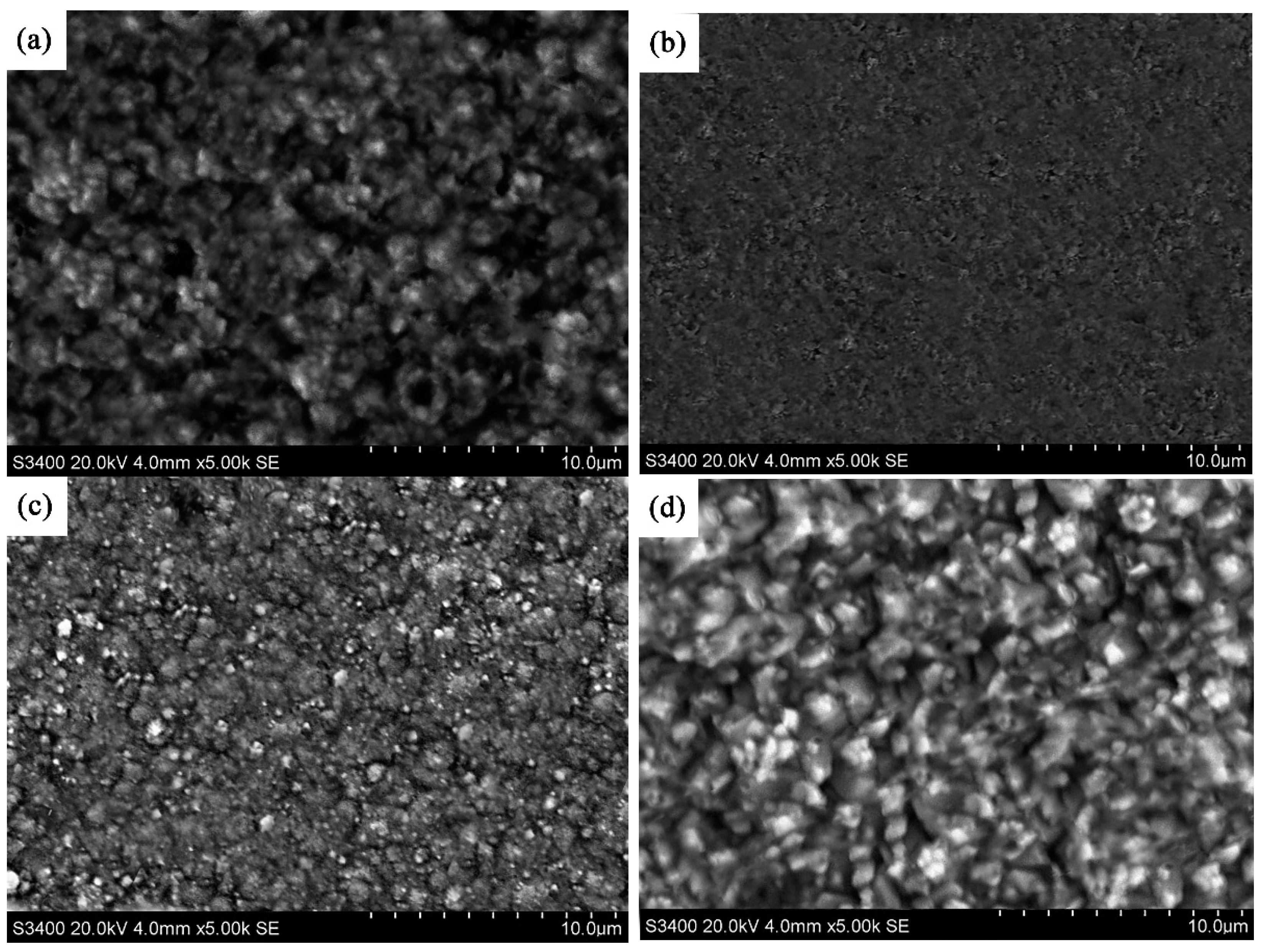
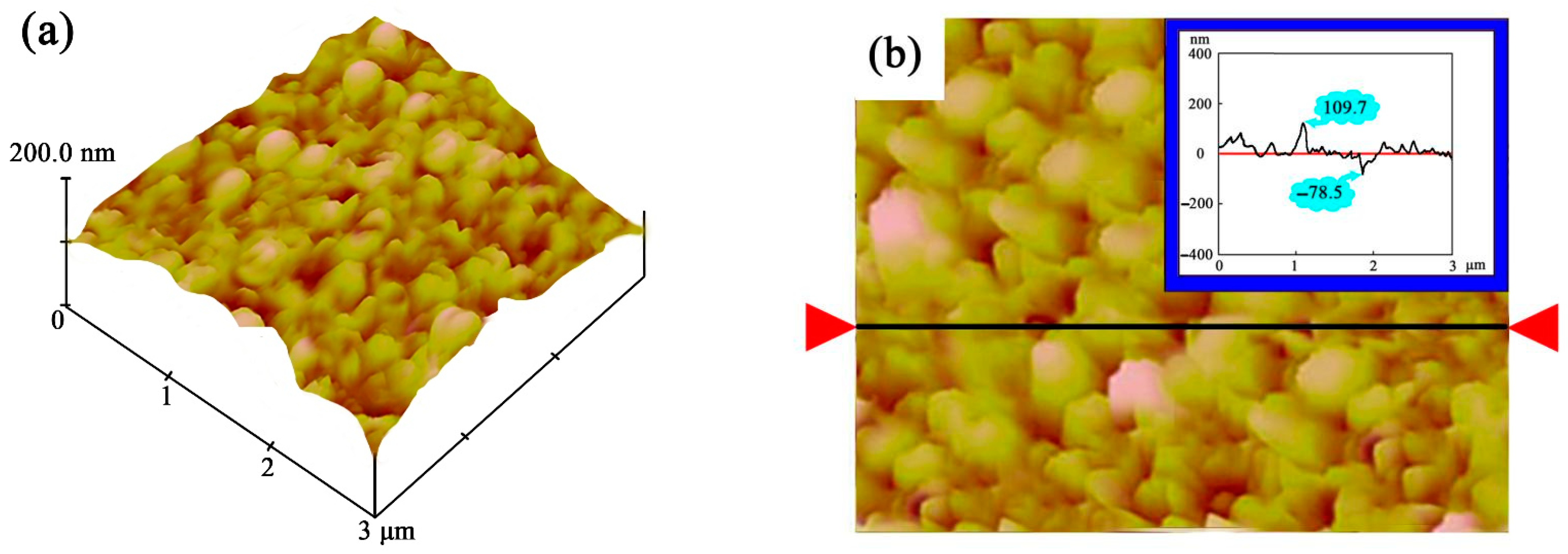
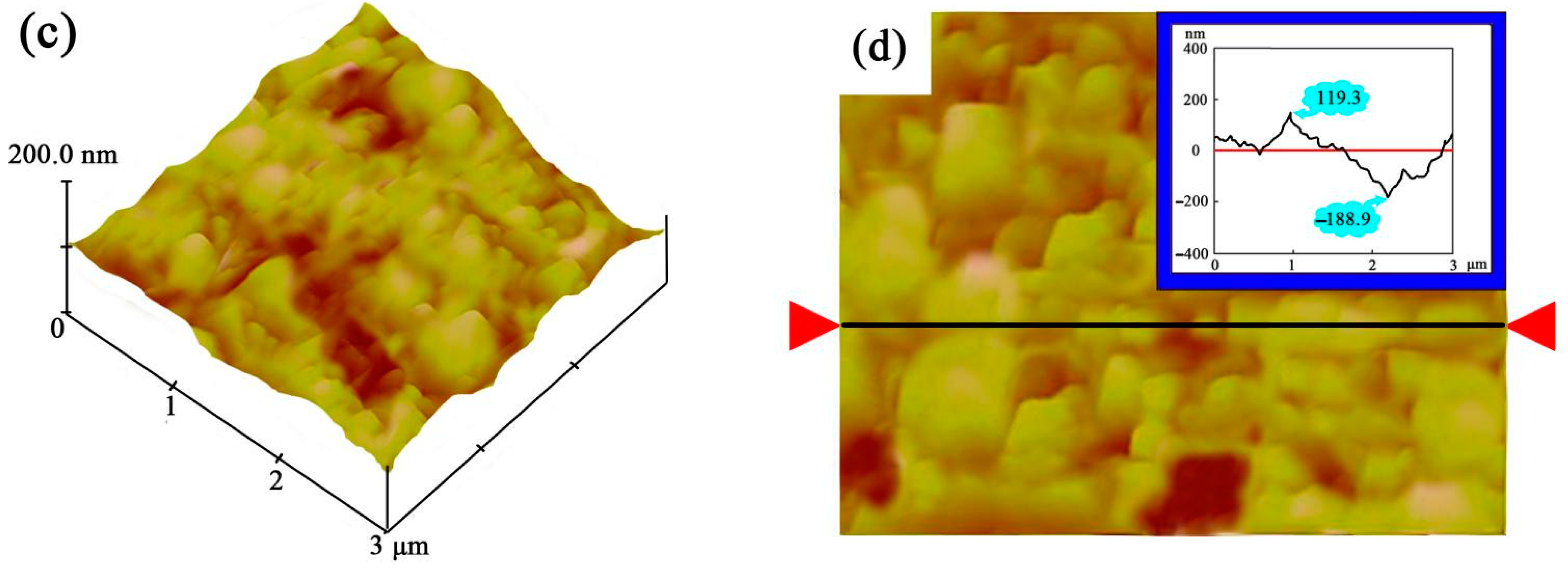
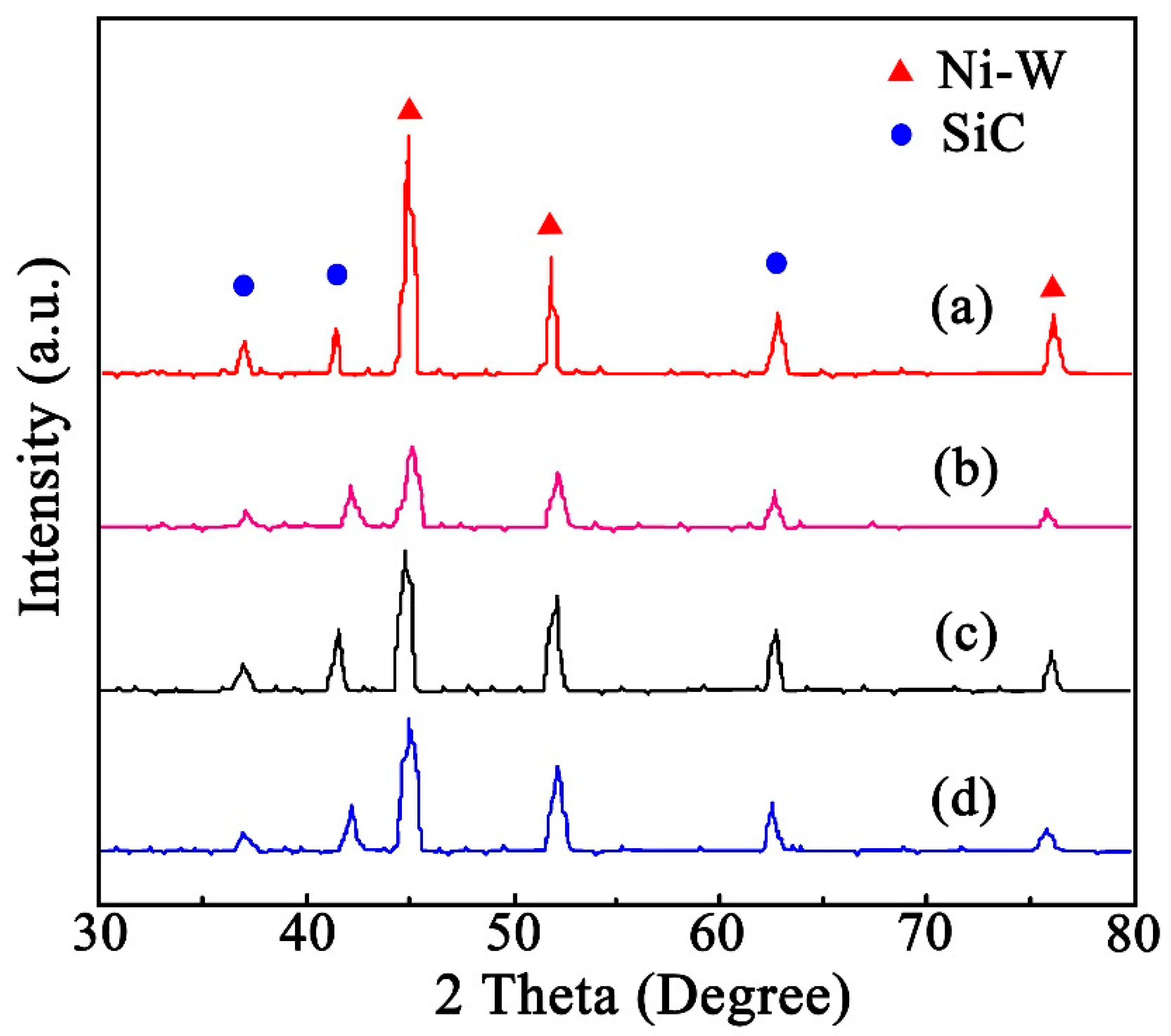
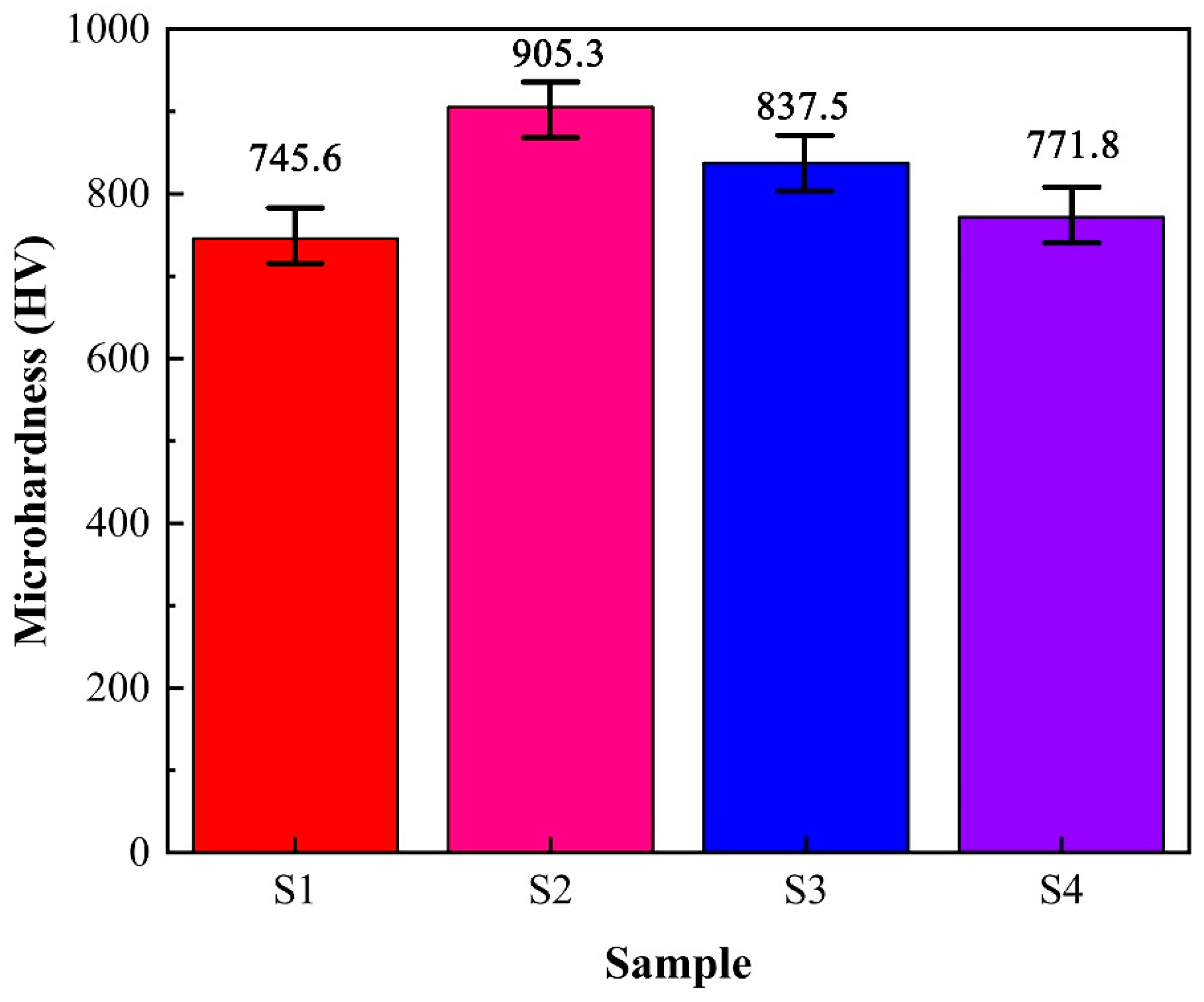
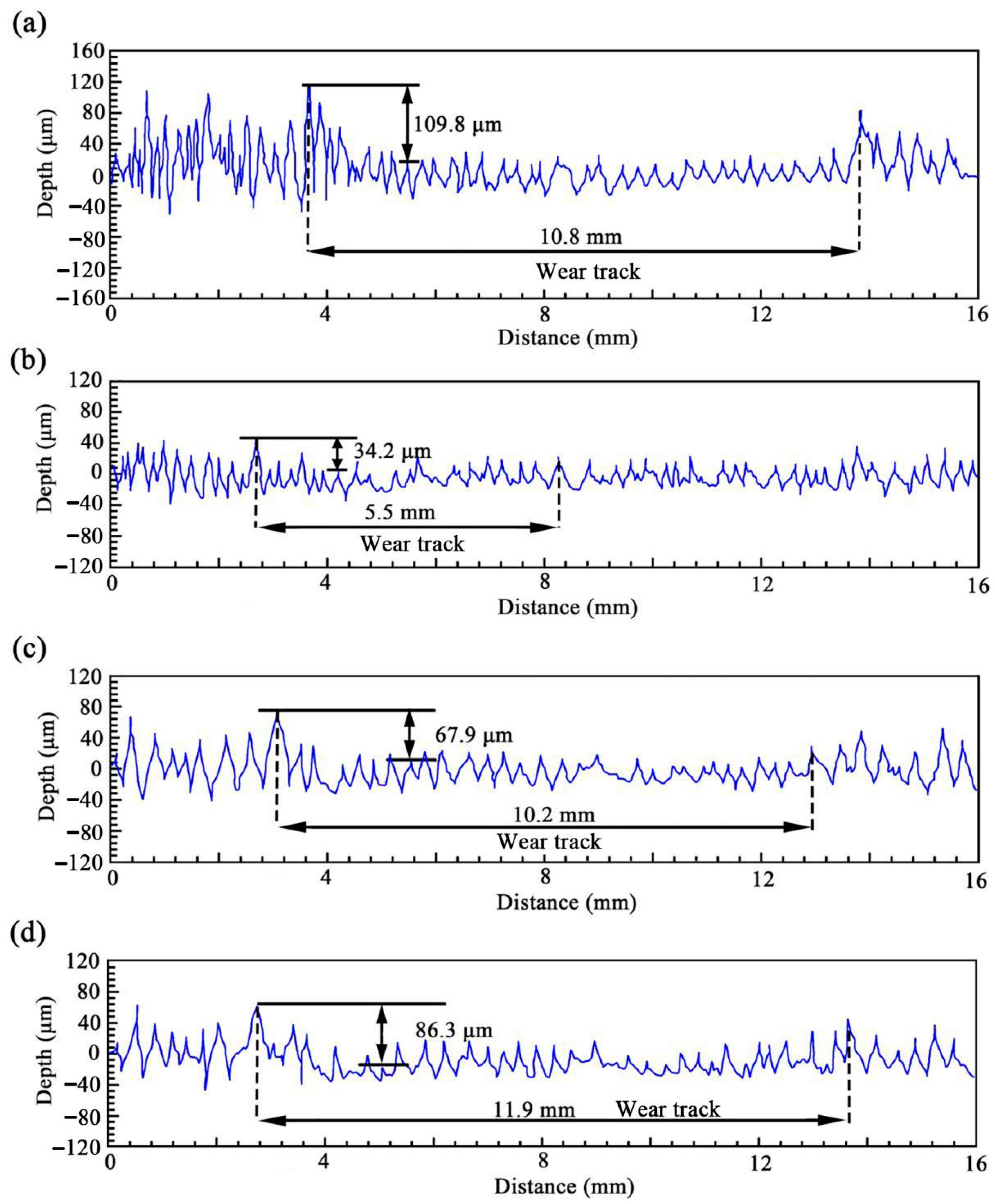
| Compositions | Parameters |
|---|---|
| Na2WO4 × 2H2O (g/L) | 30 |
| NiSO4 × 6H2O (g/L) | 58 |
| C6H8O7 × H2O (g/L) | 65 |
| NH3H2O (mg/L) | 70 |
| SiC concentration (g/L) | 4, 7, 10, 13 |
| pH | 4.5 |
| Temperature (°C) | 46 |
| Plating Parameters | Parameters |
|---|---|
| Peak current density (A/dm2) | 35 |
| Duty cycle | 25% |
| Frequency (Hz) | 250 |
| Average current density (A/dm2) | 6.2 |
| Plating time (min) | 40 |
| Composite Type | Mean Ni/W Grain Size (nm) |
|---|---|
| S1 | 135.8 |
| S2 | 84.3 |
| S3 | 111.4 |
| S4 | 147.6 |
Disclaimer/Publisher’s Note: The statements, opinions and data contained in all publications are solely those of the individual author(s) and contributor(s) and not of MDPI and/or the editor(s). MDPI and/or the editor(s) disclaim responsibility for any injury to people or property resulting from any ideas, methods, instructions or products referred to in the content. |
© 2023 by the authors. Licensee MDPI, Basel, Switzerland. This article is an open access article distributed under the terms and conditions of the Creative Commons Attribution (CC BY) license (https://creativecommons.org/licenses/by/4.0/).
Share and Cite
Zhu, Z.; Zou, L.; Li, H.; Zhang, H. Preparation and Characterization of Pulse Electrodeposited Ni/W-SiC Nanocomposite Coating on Mild Steel Substrate. Coatings 2023, 13, 484. https://doi.org/10.3390/coatings13030484
Zhu Z, Zou L, Li H, Zhang H. Preparation and Characterization of Pulse Electrodeposited Ni/W-SiC Nanocomposite Coating on Mild Steel Substrate. Coatings. 2023; 13(3):484. https://doi.org/10.3390/coatings13030484
Chicago/Turabian StyleZhu, Zhaoge, Longqing Zou, Huaxing Li, and Hongbin Zhang. 2023. "Preparation and Characterization of Pulse Electrodeposited Ni/W-SiC Nanocomposite Coating on Mild Steel Substrate" Coatings 13, no. 3: 484. https://doi.org/10.3390/coatings13030484




